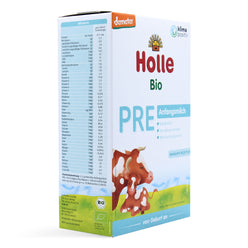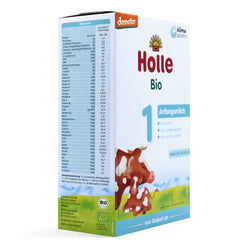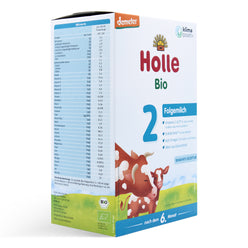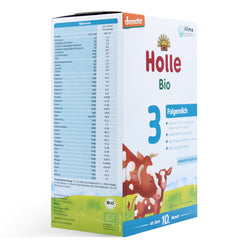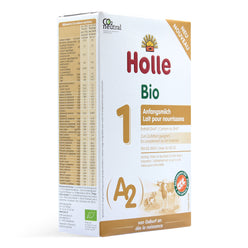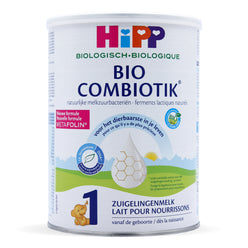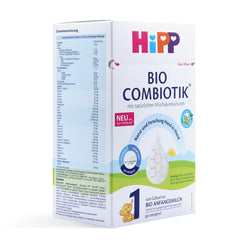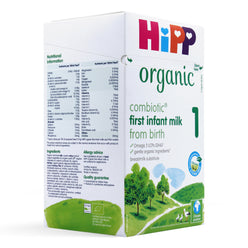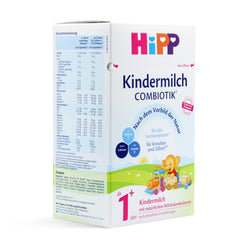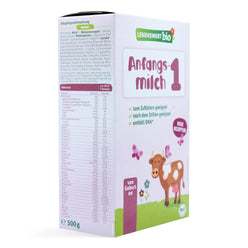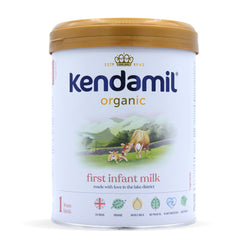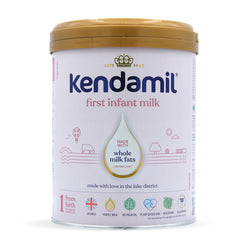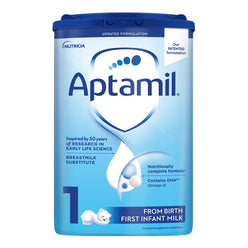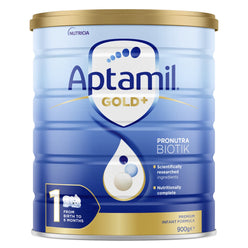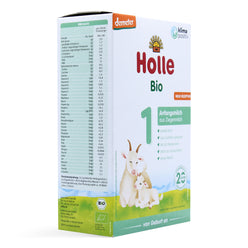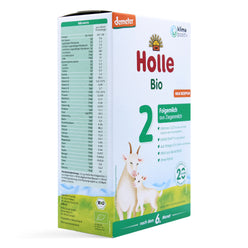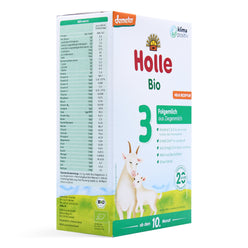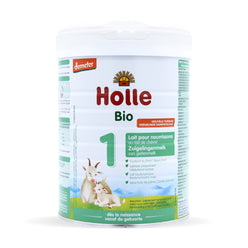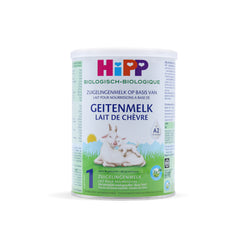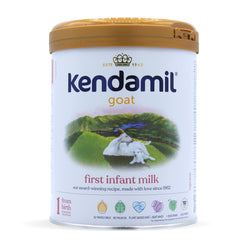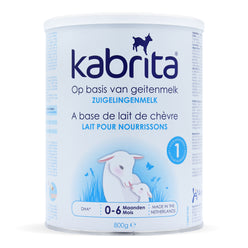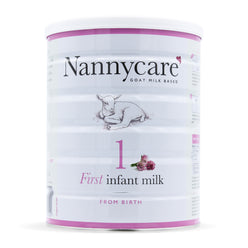Goat & Cow Milk Formula - Parent Guide to All The Differences
57 hours of research 5 minute read

Infant formula comes from cow milk, with altered casein ratios to whey proteins, usually done by adding additional whey proteins. However, with increased awareness, the demand for goat milk has grown tremendously over the past few years; this article explores the main differences between goat milk and cow milk-based formulas. (1)(2)
How Are Goat and Cow Milk Formulas Different?
According to the American Academy of Pediatrics, no children should feed on pure whole milk, whether from a cow or a goat. Instead, babies under one year of age should either be fed breast milk from the mother or milk formulas mainly designed for babies of this age. It may not develop the infant's digestive system enough to digest the whole proteins found in natural goat or cow milk. Moreover, it does not contain all the necessary elements like vitamins and minerals that the baby may require for its growth. These include iron and folic acid.
Infant formulas are made by extracting proteins like Whey and Casein, sugars like lactose, and fats like DHA and ALA. These contents then become easily digestible by infants. Most infant formulas are also fortified with minerals, vitamins, and even some healthy fats to further aid in their growth and development.
After the baby reaches one year, they may start on whole milk, which you may continue until two years. The parents may also benefit by consulting a pediatrician about their child's nutritional needs and which milk formula may be most appropriate.
What is Cow Milk Formula

Cow milk formula is used for the majority of infant milk and feeds. This formula milk contains a higher level of minerals, proteins, and fats than breast milk. However, the cow milk is usually skimmed and diluted to resemble the breast milk closely. (3) (4) While cow milk formula is considered safe for children under 1, cow milk itself is preferred. (5)
Holle Bio Stage PRE Organic Infant Milk Formula Best Seller
✓ Clean formula ingredients
✓ Demeter biodynamic certified
✓ Contains natural whey, DHA, & ALA
✓ Holle's most popular cow formula
Check Price✓ Clean formula ingredients
✓ Demeter biodynamic certified
✓ Contains natural whey, DHA, & ALA
✓ Holle's most popular cow formula
Check Price✓ Clean formula ingredients
✓ Demeter biodynamic certified
✓ Contains natural whey, DHA, & ALA
✓ Holle's most popular cow formula
Check Price✓ Clean formula ingredients
✓ Demeter biodynamic certified
✓ Contains natural whey, DHA, & ALA
✓ Holle's most popular cow formula
Check Price✓ Clean formula ingredients
✓ Demeter biodynamic certified
✓ Contains natural whey, DHA, & ALA
✓ Holle's most popular cow formula
Check Price✓ Clean formula ingredients
✓ Demeter biodynamic certified
✓ Contains natural whey, DHA, & ALA
✓ Contains A2 milk protein for easier digestion
Check PriceHiPP Dutch Combiotic Formula Best Seller
✓ Contains Probiotics & Prebiotics
✓ No sugar, no corn syrup, no soy
✓ No starch
✓ HiPP's most popular formula
Check Price✓ Contains Probiotics & Prebiotics
✓ No sugar or corn syrup
✓ No soy
✓ HiPP's original formula
Check Price✓ 100% Organic Formula
✓ No sugar, no corn syrup, no soy
✓ No starch
✓ Popular formula against constipation, indigestion, or gas
Check Price✓ 100% Organic Formula
✓ Has Prebiotics and Probiotics
✓ No sugar, no corn syrup, no soy
✓ HiPP German formula for toddlers
Check Price✓ Bioland certified (Organic++)
✓ No sugar, no corn syrup, no soy
✓ DHA & ALA for brain development
✓ Popular for babies with stomach trouble and constipation
Check Price✓ Whole Milk as a Natural Mammal Fat Source
✓ Contains Plant-Based DHA and ARA
✓ No sugar, no corn syrup, no soy, no palm oil
✓ EU and British Soil Association Certified Organic
Check Price✓ 100% Vegetarian Formula
✓ Contains Plant-Based DHA and ARA
✓ No sugar, no corn syrup, no soy, no palm oil
✓ Made from full cream cow's milk
✓ Kendamil's most popular go-to infant cow's milk formula
Check Price✓ Allergy-Friendly (No Gluten, Wheat, or Nuts)
✓ Omega 3 & 6 LCPs (DHA & ALA)
✓ Ethically sourced ingredients
✓ Patented prebiotics for healthy gut and immune system development
Check Price✓ Allergy-Friendly (No Gluten, Wheat, or Nuts)
✓ Omega 3 & 6 LCPs (DHA & ALA)
✓ With Prebiotics and Probiotics
✓ Offers a unique blend of key nutrients for babies
Check PriceWhat is Goat Milk Formula?

Goat milk has historically provided nutrition to humans. Numerous studies explore this milk's nutritional values and specific properties that might make it superior to cow milk. While pure unprocessed goat milk has been a topic of discussion in various clinical studies, the goat milk formula is now the most recent topic of concern. These studies have found goat milk to contain lower protein concentrations than cow milk. (6)
✓ Age: Birth-6 months (including premature babies)
✓ No palm oil
✓ Contains natural whey, DHA, & ALA
Check Price✓ 100% GMO-free
✓ No palm oil
✓ Contains natural whey, DHA, & ALA
✓ Demeter certified (Organic++)
Check Price✓ 100% Organic Formula
✓ No sugar, corn syrup, or soy
✓ Contains Prebiotics, DHA, and ALA
✓ HiPP's most popular goat milk formula
Check Price✓ No sugar, no corn syrup, no soy, no palm oil
✓ Contains Lactose with a Low Glycemic Index
✓ Contains DHA, & ALA
✓ Popular for digestive issues or allergy to cow’s milk
Check Price✓ Contains natural whey, DHA, and ALA
✓ No soy, corn syrup, maltodextrin, or starch
✓ 100% Non-GMO formula
✓ Easy to digest goat milk formula for sensitive babies
Check Price✓ No soy, palm oil, corn syrup, maltodextrin, or starch
✓ Contains DHA & ALA
✓ 100% Non-GMO formula
✓ Premium goat milk formula ideal for gentle stomachs
Check PriceCow Milk Vs. Goat Milk
A common question among new parents considering formula milk for their infants is the difference between a cow and goat milk. However, experts state that there aren't many significant differences between the two. However, you may find minor differences based on the concentration of fats, proteins, vitamins, and variations in flavor and smell.
1. Flavor and Color
The most apparent difference between goat milk in cow milk is the difference in flavor and texture of the two. It may be more evident to the baby, especially if they switch to goat milk from cow milk. Their taste buds are familiar with the cow milk, its smell, and its texture, and they may not immediately get used to the taste of goat milk.
Goat milk is naturally homogenized, while the farmers usually homogenize milk after extraction. Moreover, the cow milk appears more yellowish, while the goat milk is pure white. This difference is due to the increased level of carotene found in cow milk, which gives it a yellowish tinge. While flavor and color may differ between the two, the consistency of cow and goat milk is more or less the same.
2. Fat Content
The fat content found in goat milk and cow milk is similar. However, goat milk is more comfortable for the baby's digestive system. It is because goat milk includes much smaller fat molecules than those found in cow milk. This smaller size allows it to be broken down much more quickly in the infant's body than those found in cow milk. Goat milk also contains more medium-sized fatty acid chains than cow milk. These more easily absorb into the body than long-chained heavy acid chains, present in higher numbers in cow milk. Goat milk contains a higher level of omega-six fatty acids than cow milk. Hence this is usually added to the cow milk-based formulas.
3. Protein Content
Cow and goat milk usually contains a combination of two milk proteins known as Casein and Whey. Cow milk contains 80% of casein, a complex protein larger than whey. Compared to cow milk, the proportion of casein in human breast milk is much lower. You may find it in the ratio of 50:50 or as low as 20:80. The proteins naturally found in cow milk are usually adjusted while making infant milk formulas resemble breast milk. Moreover, cow milk contains different triggering factors or allergens that may be perceived as foreign invaders by the infant's body. It may result in an allergic reaction.
Compared to cow milk, goat milk contains fewer allergen proteins, making it safer for infants with sensitive digestive systems. Examples of these proteins include Alpha S1 Casein. Goat milk contains only 11% of the casein protein found in cow milk.
If you have doubts about the infant having an allergic reaction to the milk you are giving the baby, you should always consult a pediatrician first. Simple switching from cow milk to goat milk may not be enough for the baby, as the similarity between the milk may still trigger an allergic reaction. The proteins found in goat milk form a soft and light curd in the stomach, easy on the infant's stomach, and more efficiently digested. On the other hand, the cow milk proteins form a heavier and firmer curd, which may present with infants' digestive problems.
4. Lactose Content
The most common sugar found in goat and cow milk is lactose. While this carbohydrate is in both cow and goat milk, its concentration is much lower in goat milk, so that goat milk may be better for lactose intolerant individuals. However, goat milk may not be used as alertness for cow milk in infants with severe lactose intolerance - it may only be considered a safe alternative for mild forms.
5. Vitamins and Minerals Content
Cow milk and goat milk contain high essential macro and micronutrients required for infant growth. While the macronutrients include carbohydrates, proteins, and fats, the macronutrients include vitamins and minerals.
However, there are some differences between the two types of milk. Goat milk has higher Vitamin A and minerals levels like Calcium and Potassium. On the other hand, Cow milk contains a higher level of minerals like Selenium and Folic Acid. It is why baby formulas are often fortified with all the necessary vitamins and minerals to meet the baby's nutritional requirements. It helps to mimic the nutritional value found naturally in breast milk as much as possible. The vitamins commonly added to the infant formulas include Vitamin A, Vitamin B12, and Vitamin K. On the other hand, the minerals they may add have potassium, magnesium, and calcium.
Goat & Cow Milk Formula
Cow milk and goat milk provide the baby with the nutrients they require to grow, develop and live a healthy life. As all infant formulas mimic breast milk as closely as possible, cow and goat milk-based formulas are often fortified by adding extra minerals and vitamins to make them even more beneficial for the baby. It also allows both forms of milk formulas to have similar nutritional values.
However, the significant difference between the two is the presence of specific proteins and carbohydrates like lactose. Since goat milk contains lower levels of lactose and lower ratios of casein to whey protein, it is considered much gentler on the baby's digestive system. You should always consult a pediatrician while deciding which baby formula might be appropriate for your baby.
Most Popular Holle Formula
References:
- Zhou, S. J., Sullivan, T., Gibson, R. A., Lönnerdal, B., Prosser, C. G., Lowry, D. J., & Makrides, M. (2014). Nutritional adequacy of goat milk infant formulas for term infants: a double-blind randomised controlled trial. The British journal of nutrition, 111(9), 1641–1651. https://doi.org/10.1017/S0007114513004212
- Xu, M., Wang, Y., Dai, Z., Zhang, Y., Li, Y., & Wang, J. (2015). Comparison of growth and nutritional status in infants receiving goat milk-based formula and cow milk-based formula: a randomized, double-blind study. Food & nutrition research, 59, 28613. https://doi.org/10.3402/fnr.v59.28613
- Koletzko, B., Baker, S., Cleghorn, G., Neto, U. F., Gopalan, S., Hernell, O., Hock, Q. S., Jirapinyo, P., Lonnerdal, B., Pencharz, P., Pzyrembel, H., Ramirez-Mayans, J., Shamir, R., Turck, D., Yamashiro, Y., & Zong-Yi, D. (2005). Global standard for the composition of infant formula: recommendations of an ESPGHAN coordinated international expert group. Journal of pediatric gastroenterology and nutrition, 41(5), 584–599. https://doi.org/10.1097/01.mpg.0000187817.38836.42
- Cook D. A. (1989). Nutrient levels in infant formulas: technical considerations. The Journal of nutrition, 119(12 Suppl), 1773–1778. https://doi.org/10.1093/jn/119.suppl_12.1773
- Koletzko, B., Beyer, J., Brands, B., Demmelmair, H., Grote, V., Haile, G., Gruszfeld, D., Rzehak, P., Socha, P., Weber, M., & European Childhood Obesity Trial Study Group (2013). Early influences of nutrition on postnatal growth. Nestle Nutrition Institute workshop series, 71, 11–27. https://doi.org/10.1159/000342533
- Prosser C. G. (2021). Compositional and functional characteristics of goat milk and relevance as a base for infant formula. Journal of food science, 86(2), 257–265. https://doi.org/10.1111/1750-3841.15574


